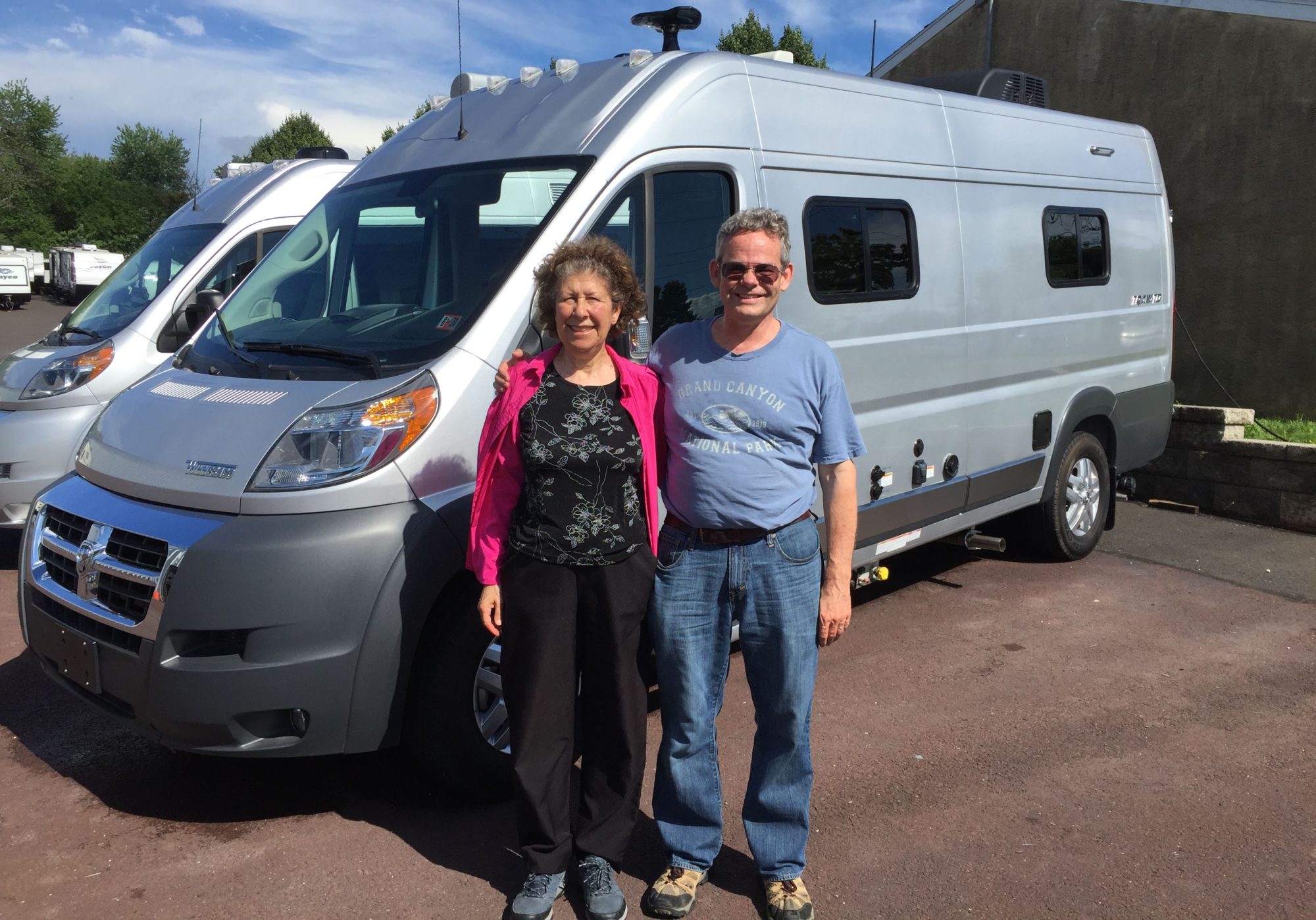Feb. 15: Our trip from Lake Marion to Savannah was somewhat exciting. After the tree was cleared from the road and we were able to proceed, we got onto I 95, a very major multi-lane north-south route. Despite the rain, traffic was moving well. Suddenly, our phones began to wail – tornado warning!
What do you do in tornado weather when you are going 60 mph on a major road in a large RV (which feels every gust of wind and passing truck) towing a car which has 2 sail-like kayaks on the roof? I was in favor of pulling over, even though there was no shelter. Chuck was in favor of carrying on. I anxiously scanned the skies for funnel clouds but it did not even look particularly cloudy. The weather app continued to insist that there was a warning, and in fact the phones howled again. (Since then, I have been told that stopping under an underpass is best, when feasible – I am not sure this would work on I 95.)
When we finally got to a truck stop, the skies were blue, the rain had stopped and wind was minimal. However, the person who was in charge of the propane told us that he could not open the pumps due to the storm conditions, and that he had watched the tornado front move parallel to I95 but about a mile to the west on a weather radar channel. There had been consider tornado damage in Georgia a couple of weeks earlier, but this time the storm did not touch down.
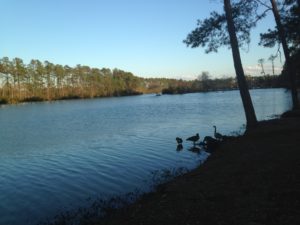 The remainder of the trip was uneventful. Our KOA campground has a small attractive lake with many domestic mute swans, lots of Canada geese and cormorants. The lake is lined with alligator warnings, but no alligators so far. The campground also has many, many dogs.
The remainder of the trip was uneventful. Our KOA campground has a small attractive lake with many domestic mute swans, lots of Canada geese and cormorants. The lake is lined with alligator warnings, but no alligators so far. The campground also has many, many dogs.
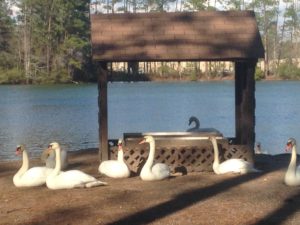 Our campsite is on the opposite edge of the campground from the lake, and overlooks a new growth woodland owned by a hunting club – no signs of hunting, however.
Our campsite is on the opposite edge of the campground from the lake, and overlooks a new growth woodland owned by a hunting club – no signs of hunting, however.
Chuck has been working mornings, so we are spending only the afternoons and evenings on sightseeing. That seems to work well for Savannah, however, as eight hours of being tourists is sufficient for us, and Savannah is hopping in the evening.
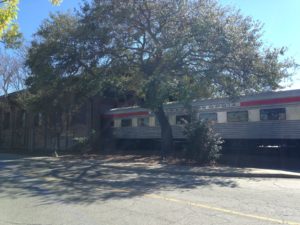 The Savannah tourist information bureau is in the old train station, along with the Savannah History Museum. It has a huge parking lot. Uniquely, it allows RV overnight parking. We did not take advantage of this, but it is a very convenient location in the heart of the historic city (no utilities, however). The train that appears to be entering the Visitor Center is used as office space.
The Savannah tourist information bureau is in the old train station, along with the Savannah History Museum. It has a huge parking lot. Uniquely, it allows RV overnight parking. We did not take advantage of this, but it is a very convenient location in the heart of the historic city (no utilities, however). The train that appears to be entering the Visitor Center is used as office space.
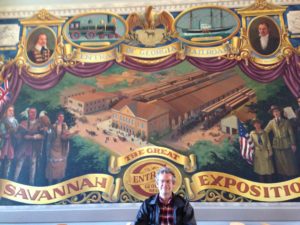
This beautiful mural with historic scenes is the first thing that greets visitors inside the Visitor Center.
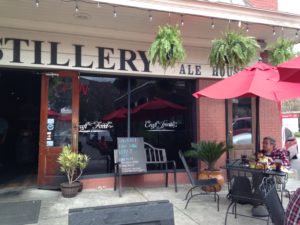
Just across the road from the Savannah Visitor Center is the Distillery, a brewhouse restaurant in a building that went from pub to drugstore (during Prohibition) and back to pub. It seems to have a great selection of beers. For us the attraction was that we could sit outside with Rumple. Not only were they fine with Rumple, on our first visit he was served 4 little dog biscuits on his own plate! We had lunch there every day we visited Savannah.
On our first visit, we went to the Historical Museum, which had a fine historical display, as well as information about industry in Savannah and of course the Revolutionary and Civil Wars. The Patriots suffered a devastating loss in Savannah, and it continued to be occupied by the British well after the surrender of Cornwallis at Yorktown. During the Civil War, Savannah surrendered to Sherman, thus escaping the destruction suffered by Sherman’s March to the Sea campaign.
An interesting exhibit at the History Museum documented the life of Juliet “Daisy” Gordon Low, the founder of the American Girl Scouts. A southern socialite, she married well and moved to England with her husband. When he turned out to be an unfaithful louse, she divorced him. In the meantime, she had developed a lot of practical skills, including both those typical for a woman of her status at the time, like painting, and atypical, such as artistic blacksmithing and nursing. When she met Sir Baden-Powell, founder of the Boy Scouts, she became enamored of the idea of working with the Girl Guides, the sister organization started by Baden-Powell’s sister. After organizing troupes in Scotland and England, she moved back to Savannah where she started the movement, and renamed it Girl Scouts. (In Canada, it is still Girl Guides.) She encouraged the girls to gain practical skills while having fun, and with her wide interests provided many opportunities. The headquarters of the Girl Scouts of America is still in Savannah.
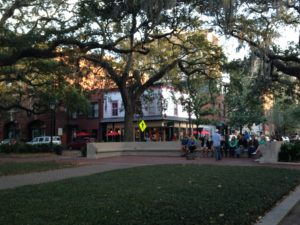 Historic Savannah is beautiful – there is no other word for it. There are mature live oaks, spreading massive branches over gardens bright with azaleas.
Historic Savannah is beautiful – there is no other word for it. There are mature live oaks, spreading massive branches over gardens bright with azaleas. 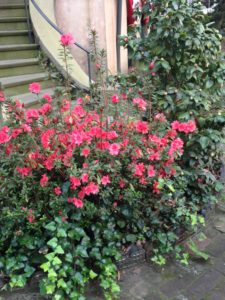
There are beautiful old state houses and lovely row houses. There are many old big churches and synagogues. And there are two restaurant/night life districts.
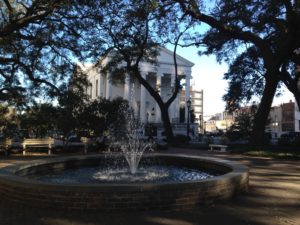
Savannah was constructed so that each neighborhood was built around a commons – now a square, with residential units on one side and “trust” lands on the other. Originally there were 4 squares laid out – then 6. Currently, there are 22 of these squares, mostly laid out in a grid so that the connecting streets are all interrupted by the squares, and the major roads run unobstructed between them. All of the squares have gardens and benches – many have historical monuments or fountains or other points of interest. Both the squares and the major streets are shaded by massive live oaks. Many of the squares also border beautiful old houses of worship and huge stately homes (some of which are now open as museums). It is all compact enough to handle on foot.
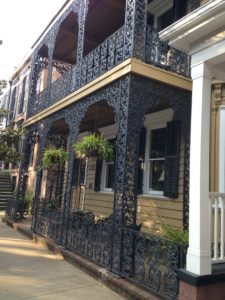
This house is likely not historic, but I liked the ironwork.
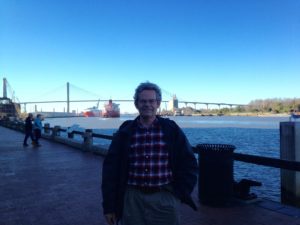
T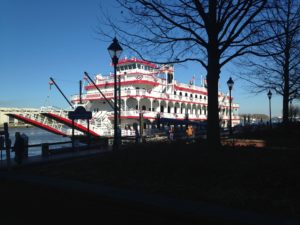 he city sits on a cliff over the Savannah River. The river bank is now a park, while the cliff face houses touristy shops and restaurants. At the street level above, a couple of blocks inland, is the City Market, which comes alive at night with outdoor restaurant seating and live music.
he city sits on a cliff over the Savannah River. The river bank is now a park, while the cliff face houses touristy shops and restaurants. At the street level above, a couple of blocks inland, is the City Market, which comes alive at night with outdoor restaurant seating and live music.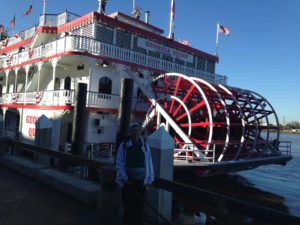
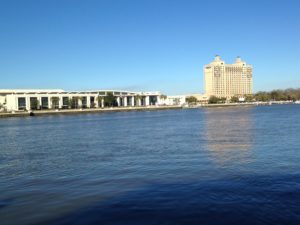
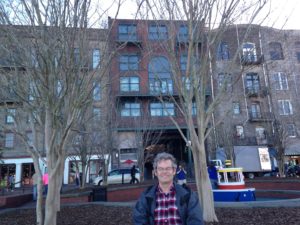
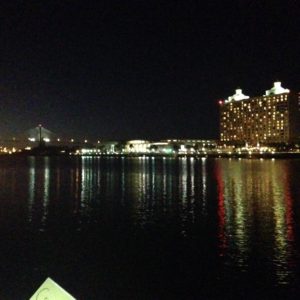
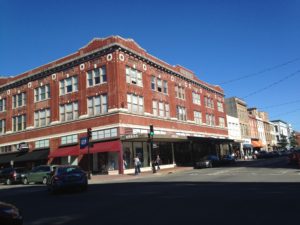
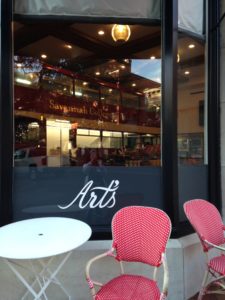 Another feature of the historic city is the Savannah College of Art and Design, which seems to occupy just about every large building, particularly the historic ones, including a former synagogue (below).
Another feature of the historic city is the Savannah College of Art and Design, which seems to occupy just about every large building, particularly the historic ones, including a former synagogue (below).
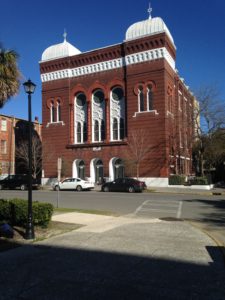 There are many, many shops selling beautiful artwork, presumably by SCAD students. And a cute SCAD coffee shop.
There are many, many shops selling beautiful artwork, presumably by SCAD students. And a cute SCAD coffee shop.
Once we were “museumed out” we walked around downtown, through the lovely squares and also along the river front. During our walk, we discovered an Irish pub that offered nightly music, so we went back there for dinner. The singer was very good, with a repertoire that was clearly Irish or Irish-Canadian, but covered mostly songs we had not heard before. He was also very entertaining between sets, and could have done fine as a stand-up comedian.
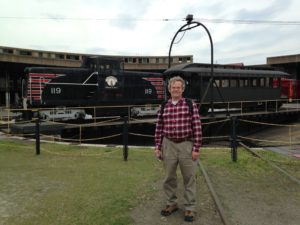 Day two in Savannah was somewhat of a repeat of day 1. We started at the Railway Museum, which turned out to be the repair shops that serviced the trains. We did two tours – one of the workshop for the freight cars, which included a tour of actual freight cars, and the other of the executive carriage cars which were used by the railway executives for their trips and to entertain clients.
Day two in Savannah was somewhat of a repeat of day 1. We started at the Railway Museum, which turned out to be the repair shops that serviced the trains. We did two tours – one of the workshop for the freight cars, which included a tour of actual freight cars, and the other of the executive carriage cars which were used by the railway executives for their trips and to entertain clients.
It w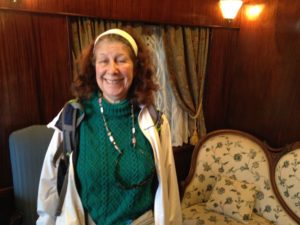 as striking that at least some of the design features of our RV date back to these luxury cars. Unfortunately, the RV does not come with valet and cook.
as striking that at least some of the design features of our RV date back to these luxury cars. Unfortunately, the RV does not come with valet and cook.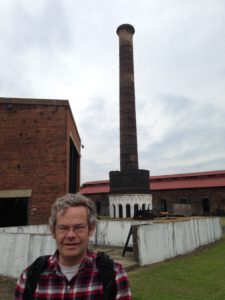
This is the chimney in the train repair yard.
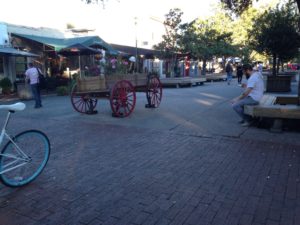 The remainder of the day we just enjoyed the ambience. We had dinner outside at the City Market and enjoyed the music. We enjoyed peach sangria as the evening fell.
The remainder of the day we just enjoyed the ambience. We had dinner outside at the City Market and enjoyed the music. We enjoyed peach sangria as the evening fell.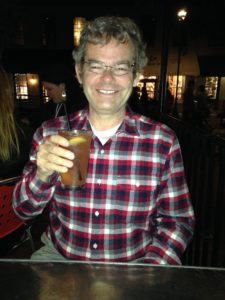
On our final day in Savannah, we decided to just walk around, finishing with dinner at the Irish pub. Savannah was having an Irish festival, and the singer at the Irish pub had noted that it was likely that many performers would be coming back in the evening for a pint and an informal session.
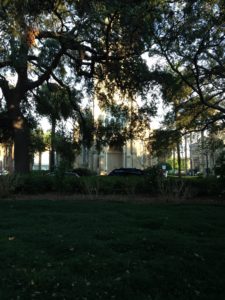 We decided to split up for our walking tour, as Chuck wanted to go to a book fair, and I wanted to see the synagogue. My walk took me past several of the large churches as well. Since it was the weekend, the synagogue and all the churches were closed to tourism, but it was still interesting to see the buildings. If I had not deliberately set out to see the synagogue, I would have assumed it was also a church, as it had no artistic or architectural details that indicated otherwise. It can just be seen through the trees in this photo.
We decided to split up for our walking tour, as Chuck wanted to go to a book fair, and I wanted to see the synagogue. My walk took me past several of the large churches as well. Since it was the weekend, the synagogue and all the churches were closed to tourism, but it was still interesting to see the buildings. If I had not deliberately set out to see the synagogue, I would have assumed it was also a church, as it had no artistic or architectural details that indicated otherwise. It can just be seen through the trees in this photo.
We deliberated on the optimal time to put Rumple in the car and head to the pub so that we would be eating our meal late enough to keep our table for the show. Unfortunately (or perhaps fortunately) we miscalculated – no tables were available. We meandered around the tourist district and found that on Saturday evening in Savannah, waits of over an hour are the norm.
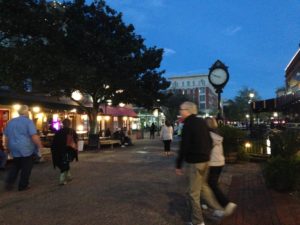 Finally, we ended back at the restaurant of the previous evening at the City Market, with the same singer providing background music. However very soon, it was not background music at all – he started playing dance tunes, and the crowd was very willing to join in. After dinner we joined the fun – it was like being at a very big outdoor wedding, with everything except the chicken dance! We had a blast!
Finally, we ended back at the restaurant of the previous evening at the City Market, with the same singer providing background music. However very soon, it was not background music at all – he started playing dance tunes, and the crowd was very willing to join in. After dinner we joined the fun – it was like being at a very big outdoor wedding, with everything except the chicken dance! We had a blast!
We love Savannah!
